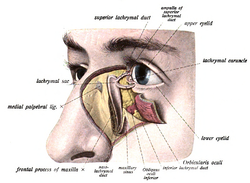| Lacrimal sac | |
|---|---|
 The lacrimal apparatusis shown through dissection on the left side. | |
 The lacrimal sac has been opened showing internal organization as well as the naso-lacrymal duct. | |
| Details | |
| Artery | Angular artery |
| Identifiers | |
| Latin | saccus lacrimalis |
| TA98 | A15.2.07.068 |
| TA2 | 6857 |
| FMA | 20289 |
| Anatomical terminology | |
The lacrimal sac or lachrymal sac[1] is the upper dilated end of the nasolacrimal duct,[2] and is lodged in a deep groove formed by the lacrimal bone and frontal process of the maxilla. It connects the lacrimal canaliculi, which drain tears from the eye's surface, and the nasolacrimal duct, which conveys this fluid into the nasal cavity.[3] Lacrimal sac occlusion leads to dacryocystitis. [4]
- ^ Dr. Johannes Sobotta (1909). Sobotta's Atlas and Textbook of Human Anatomy. Philadelphia.
{{cite book}}: CS1 maint: location missing publisher (link) - ^ Sacks, Raymond; Naidoo, Yuresh (2019-01-01). Endoscopic Dacryocystorhinostomy. pp. 143–148.e1. doi:10.1016/B978-0-323-47664-5.00017-1. ISBN 9780323476645. Retrieved 2020-05-08.
Anatomy: The lacrimal sac extends approximately 10 mm above the axilla of the middle turbinate.
- ^ Remington, Lee Ann (2012). "Ocular Adnexa and Lacrimal System". Clinical Anatomy and Physiology of the Visual System. Elsevier. pp. 159–181. doi:10.1016/b978-1-4377-1926-0.10009-8. ISBN 978-1-4377-1926-0.
The lacrimal sac lies within a fossa in the anterior portion of the medial orbital wall. This fossa is formed by the frontal process of the maxillary bone and the lacrimal bone. The sac is surrounded by fascia, continuous with the periorbita, which runs from the anterior to the posterior lacrimal crests.
- ^ Beare, Nicholas A.V.; Bastawrous, Andrew (2014). "Ophthalmology in the Tropics and Sub-tropics". Manson's Tropical Infectious Diseases. Elsevier. pp. 952–994.e1. doi:10.1016/b978-0-7020-5101-2.00068-6. ISBN 978-0-7020-5101-2.
Tears drain through the canaliculi, lacrimal sac and naso-lacrimal duct into the nose. Blockage of the naso-lacrimal duct prevents drainage of the lacrimal sac, which may lead to infection, causing a painful swelling at the side of the nose below the medial canthus. This may present as a chronically watery, discharging eye, or as an acutely inflamed abscess. This should be treated with oral broad-spectrum antibiotics. The problem may recur unless drainage into the nose is re-established.